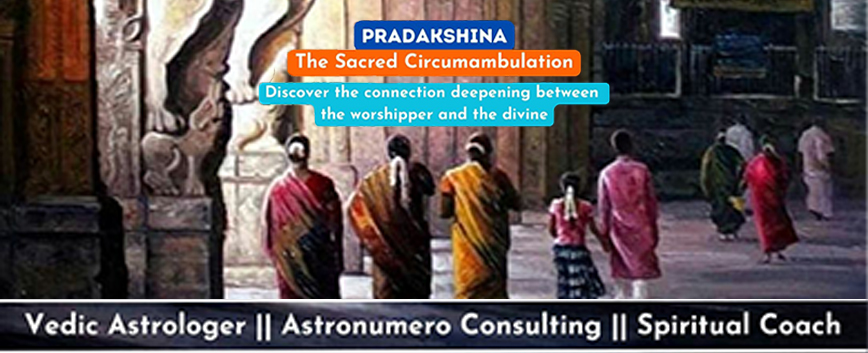
 Aug 16, 2023
Aug 16, 2023
In Hinduism, Pradakshina is a sacred and profound act of circumambulating around a deity, a holy place, or a sacred object. It symbolizes devotion, surrender, and seeking blessings. The act is believed to purify the mind, promote physical and mental well-being, and represent the cyclical nature of life and spiritual journey.
Derived from the Sanskrit words "Pra" meaning "to go forth" and "Dakshina" meaning "clockwise," Pradakshina involves walking in a circular path with the right side facing the object of reverence.
This ancient tradition carries deep spiritual significance and is practiced in various Hindu temples and pilgrimage sites across the world.
Pradakshina is not just a physical act but a symbolic expression of devotion, humility, and surrender to the divine. It represents the cyclical nature of life and the continuous journey of the soul towards enlightenment. The circumambulation is usually performed in a clockwise direction, believed to align with the natural flow of positive cosmic energy, also known as "Purusha" or "Surya Vritti." It's usually performed after the completion of traditional worship or Puja.
1. Paying Respect to the Divine:
Pradakshina is an act of reverence towards the deity or sacred place. It is believed to purify the mind and body, fostering a deeper connection with the divine, reinforcing one's devotion and reverence.
2. Symbolism of Surrender:
By circling around the object of worship, devotees symbolize their complete surrender to the higher power and the willingness to let go of ego and attachments, humbly acknowledging the supremacy.
3. Seeking Blessings and Auspiciousness:
It is believed that by performing Pradakshina, one can seek blessings, protection, and auspiciousness from the deity or holy place.
4. Karma and Liberation:
Pradakshina signifies the cycle of birth and death and represents the idea of breaking free from the cycle of Karma (actions) to attain liberation or Moksha.
5. Physical and Mental Benefits:
The act of walking during Pradakshina is seen as a form of physical exercise and meditation, promoting overall well-being and peace of mind.
6. Positive Cosmic Energy:
The clockwise direction aligns with the flow of positive cosmic energy, believed to enhance spiritual experiences.
7. Unity and Oneness:
Performing Pradakshina with fellow devotees fosters a sense of unity and oneness in the spiritual journey.
8. Cyclical Nature of Life:
By walking in a circular path, it reminds believers of the cyclical nature of existence and the continuous journey of the soul.
Pradakshina can take various forms, depending on the specific religious context:
1. Circumambulating Temples:
Devotees walk around the main sanctum sanctorum or the entire temple complex in a clockwise manner as an act of devotion.
2. Circumambulating Sacred Objects:
At pilgrimage sites, devotees perform Pradakshina around sacred rivers, mountains, or trees, which are considered embodiments of divinity.
3. Around Holy Texts:
In some traditions, Pradakshina is performed around holy scriptures like the Bhagavad Gita or the Ramayana, signifying reverence towards knowledge.
1. Atma Pradakshina:
It's generally done after completion of a vrata or Puja. As the term signifies, it's basically about going around ourselves. It signifies the destruction of ego going round like a whirlwind.
2. Paada Pradakshina:
In this, the devotees usually walk around the temple.
3. Danda Pradakshin:
Here, the person has to do Sashtanga Pranam, then take a step and perform these two alternatively one by one. ('Sa ashta ang' stands for '8 parts of the body touching the ground.'
4. Angapradakshina:
Here, the devotee has to lie prostrate & roll around the temple. It's generally done wearing wet clothes. It's considered to be the most powerful pradakshinam for wish fulfillment.
The rite of Pradakshina holds various symbolic explanations, and one of them is emulating the auspicious path marked by the course of the sun.
The Sun is often considered a symbol of divine power and illumination in Hinduism. By circumambulating in a clockwise direction, devotees symbolically follow the path of the Sun, which is seen as a source of positive cosmic energy.
This act is believed to bring blessings and auspiciousness, aligning the worshipper's life with the harmonious rhythms of the universe. It also signifies moving from darkness (ignorance) to light (knowledge) and seeking enlightenment. The concept of following the Sun's path in Pradakshina reflects the deep connection between Hindu spirituality and nature's cycles.
In some Hindu funeral ceremonies, mourners may perform a counterclockwise movement, which is known as "Prasavya." Unlike the usual clockwise Pradakshina, Prasavya involves walking in the opposite direction, with the left side facing the object of reverence or the deceased.
The counterclockwise movement during Prasavya is considered a mark of respect and signifies a departure from the normative practice. It is believed to represent the reversal of the usual life cycle, signifying the departure of the soul from the physical world and its journey towards the spiritual realm.
Prasavya during funerals, like other aspects of Hindu rituals, serves as a way to honor the departed soul, express grief, and seek solace in the spiritual beliefs about the afterlife and the soul's journey.
The practice of circumambulation is not limited to Hinduism. It is also present in other religions and cultures. For instance, in Buddhism, devotees perform "Kora" by walking around sacred stupas or monasteries in a similar clockwise manner. Even Buddhist stupas have a pre-defined pradakshina path around them.
Overall, the act of Pradakshina is considered an expression of devotion, surrender, and seeking blessings from the divine. It symbolizes the cyclical nature of life and the continuous journey of the soul towards enlightenment. The act is believed to purify the mind, foster a deeper connection with the divine, and promote physical and mental well-being.